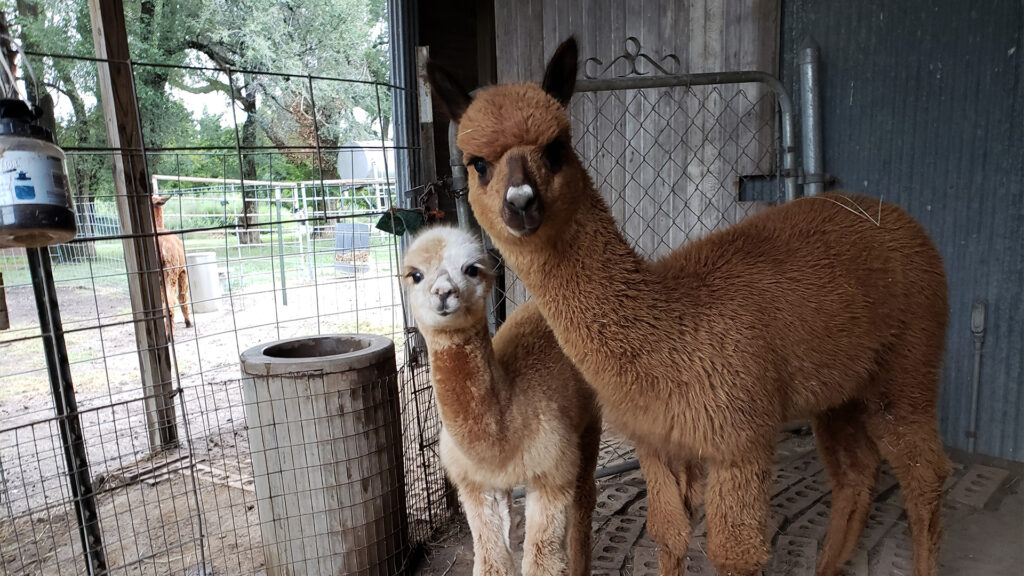Look an alpaca in the eye, and you just might wonder: “How did I get here?” In the face of this South American animal with its feline temperament and camel-like looks, it’s impossible not to smile, laugh, and reach out to scratch its neck. (Always resisting, of course, the urge to pet the head—alpacas don’t like that.) Life on the road can sure be unusual. Wonderful. And humorous.
But then again, as the long-necked beasts lope around you, you could look at it another way. Perhaps, you’ve parked in a special place, where there’s a small glimmer of Genesis—something beautiful, innocent, and ancient. At Heartland Farm, you can approach the wild without fear—and watch the wild approach you (especially if you have some bindweed in hand). Sure, on one level, the alpacas and their poofy perms are almost as absurd as Doctor Doolittle and his two-headed llama. But on another level, something deeper is going on. Maybe, just maybe, what was lost long ago east of Eden is being found just west of Great Bend, Kansas.
How did you get here? Here, with the RV parked dead-center in a drive-thru state. Here, surrounded by wooly alpacas, devout Dominican sisters, and the abiding peace of the natural world. Well, that’s one big yarn. And, you have to confess, it all starts with Harvest Hosts.

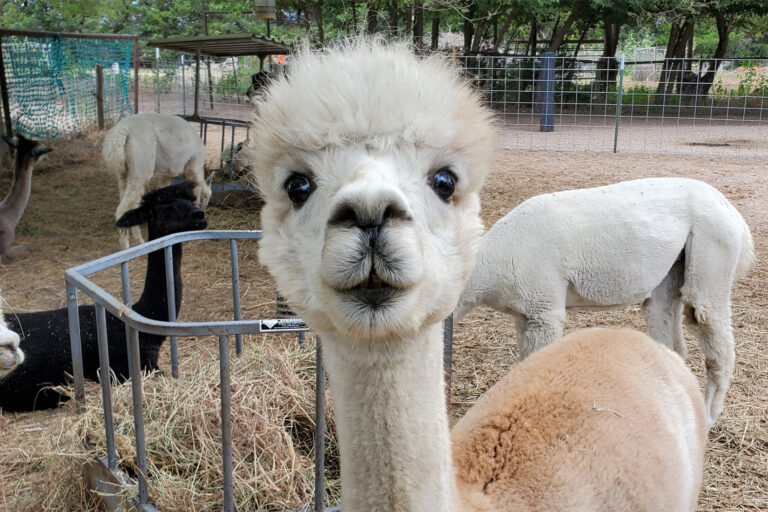
A Warm and Woolly Welcome
As you travel to Heartland Farm, there are signs that you’ve made it into the country. The county road switching to gravel—but good gravel—is one of them. None of this is unexpected, of course. Harvest Hosts members may wander toward the alpaca farm full of curiosity, but you are always under good direction once you call and check-in with the host. (And that’s good, because it’s unlikely that you’d find the farm otherwise.) Driving about 20 minutes west from Great Bend on West Barton County Road (that turns into X Road once you hit the county line), you’ll take a left at the Heartland Farm sign and turn south onto CR 390. Farmland flanks both the driver and passenger sides of the RV as you drive. Sometimes wheat. Sometimes alfalfa or milo, depending on the season. But always serene.
After a half-mile, Heartland Farm’s long driveway appears on the right. Taking the turn rolls you over a little (often dried-up) creek and west again toward a complex of farm buildings bracketed by cedar windbreaks to the west and north. The appearance of an alpaca-painted mailbox and wooden Heartland Farm sign leave no room for doubt: You’ve made it.
Immediately on arrival, one of the Dominican Sisters of Peace will walk up to meet new RV guests. One of the hosts, Sister Jane, notes (with a little irony) that the meeting is often different than some guests imagine: “One of the visuals that people tend to have about sisters is that they’re gonna look like some movie they saw.” She pauses for effect, letting iconic movie scenes from “Sister Act” and “Vertigo” appear in memory. She abruptly clarifies, “You’re gonna meet someone in jeans and a flannel shirt. … not some kind of long dress.”
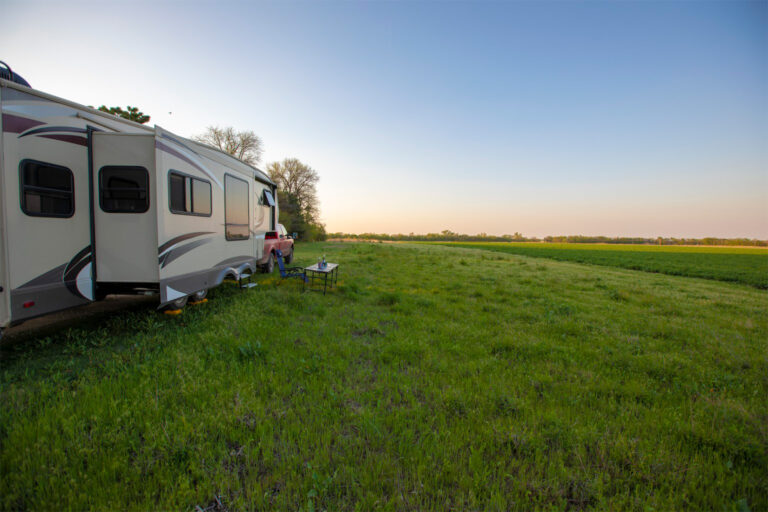
Hence the importance of calling ahead. (Sister Jane might be out working fence on the property’s 80 acres when you call.) But once you arrive, you’re welcomed by a sister and guided to your spot. Around the farm’s circular drive, the complex unfolds. The first sight: two white houses separated by an open-air pavilion. Then flower and herb gardens appear. Arcing around the corner, you will pass more houses (all named after trees), some for guests and some for resident sisters. Then past the office and gift shop, the farm opens up before you—unveiling a century-old barn, alpacas pacing across their paddock, an octagonal art studio made from straw bales, and a grain silo that’s been refurbished into a meditation space (complete with stained-glass windows). Smaller RVs pull around and park where they can look across the adjoining field.
So. Not your ordinary campground.
Teresa Johnson, who works at Heartland Farm but isn’t a sister (in the Dominican sense), points out that that is one of the farm’s virtues, “One of the really nice things for Harvest Hosts members and RVers is that we aren’t a big RV facility. We have two RV spaces.” No need to share space with a crowd. Teresa warmly reflects, “That just provides them with the opportunity to experience our little piece of heaven.”
And, for the sisters who run the farm, that’s the big idea.
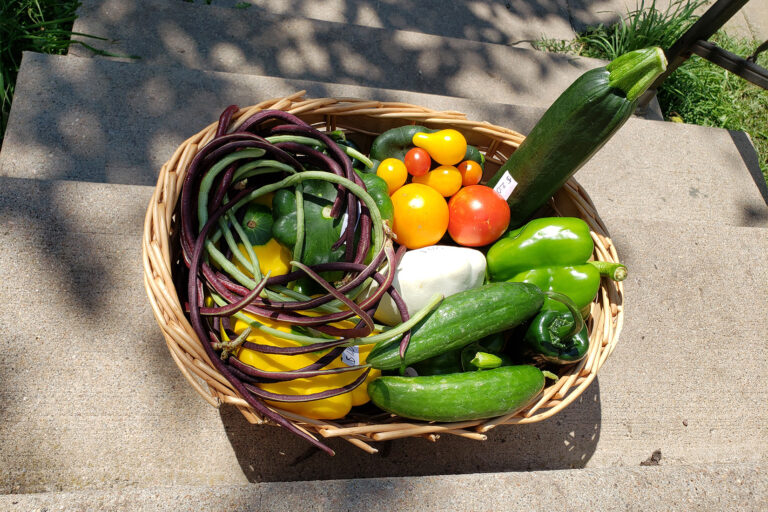
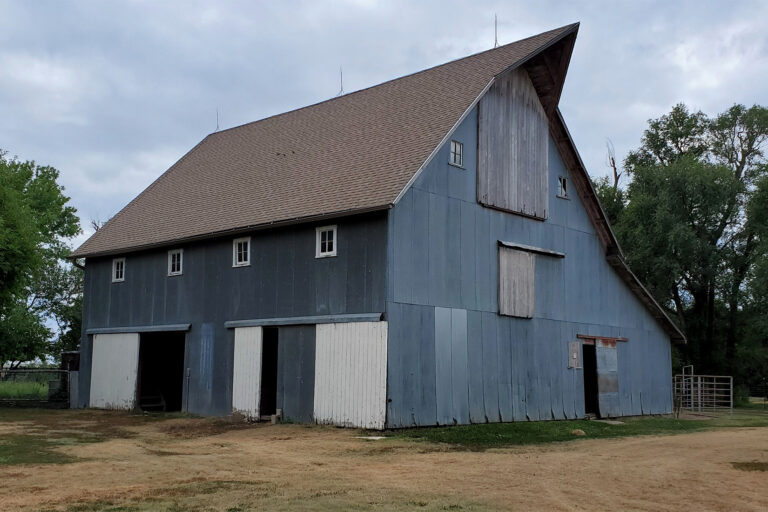
A Most Unique Host
The sisters at Heartland Farm aren’t your ordinary nuns. In fact, “nuns” isn’t even the right word. Sister Jane explains, “Accurately speaking, nuns are really the ones who stay in their monastery and pray and don’t do anything outside of that venue. Whereas sisters run the hospitals and the schools.” The Dominican Sisters have been doing just that for a long time. Like over 800 years, and more than 200 in the States. About 35 years ago, they bought the 80-acre lot of farmland with a specific mission in mind: to model what the planet needs for restoration, both the earth and the people who live on it.
In 2009, when eight different congregations merged to found Dominican Sisters of Peace, that mission didn’t change. With rural America becoming largely invisible, Sister Jane says it’s as relevant as ever. “It’s part of sharing what our mission really is. To be a place of connecting with the natural world, people connecting with themselves.” Really, she says, it’s an invitation, “It’s about inviting people into a reflective time.” And the sisters are open and welcoming to all guests. Which is important, because all kinds of guests show up to see the alpacas.
Teresa laughs when asked about the alpacas and the mission. “They’re not just here to be cute,” she clarifies. “They’re here to serve specific purposes … and to be really cute!” Teresa and Sister Jane explain that alpacas actually help keep simple skills alive.
They’re fairly easy on the land (unlike large grazing animals) and relatively easy to manage. Their warm, soft, non-allergenic fleece gets sheared once every year like sheep. It gets sent to the fleece mill and then comes back, where it’s spun into yarn. (Yes, the sisters offer classes.)
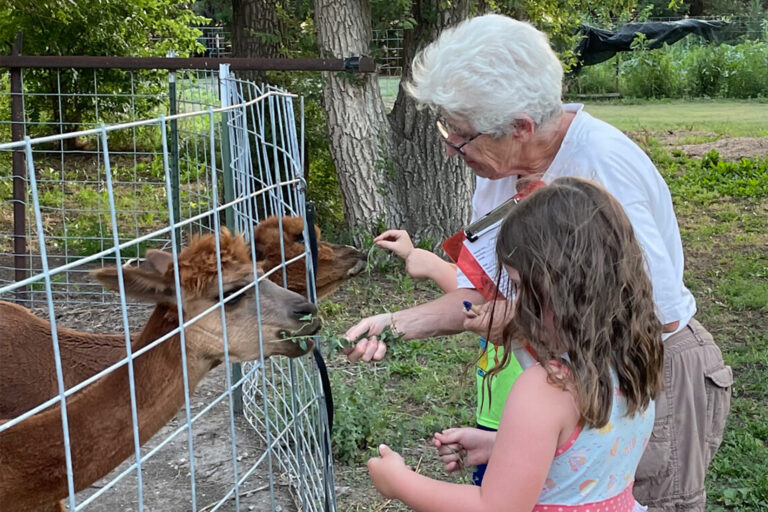
The alpacas also provide a wonderful source of fertilizer. “Alpacas are very nice about sharing,” quips Sister Jane. Volunteers and guests can even help gather the compost for the gardens if they want to get their hands dirty with farm work.
Mostly though, folks love taking pictures of them—and with them. Professionals show up to get alpacas in the golden light. Amateurs try to lure them into proximity. Sister Jane laughs, “I liken them personality-wise to cats, who will take you or leave you depending on their personality and mood.” She assures guests, “If you are patient and stand there, they will come to you.” (Especially if you want to feed them some bindweed.) A lot of people ask, “Will they spit on me?“ The answer is no, although they will spit at each other.
Whether a Harvest Hosts member is visiting for the alpacas, the rural experience, or outright curiosity, they never leave disappointed. Teresa says that the partnership with Harvest Hosts, like the farm itself, has been symbiotic. “Word of mouth via the Harvest Hosts website is really important for us. I don’t know if we’ve ever gotten a bad comment.” When asked to describe their guests, Sister Jane decisively says, “Nice people,” prompting Teresa to exclaim, “They are!”
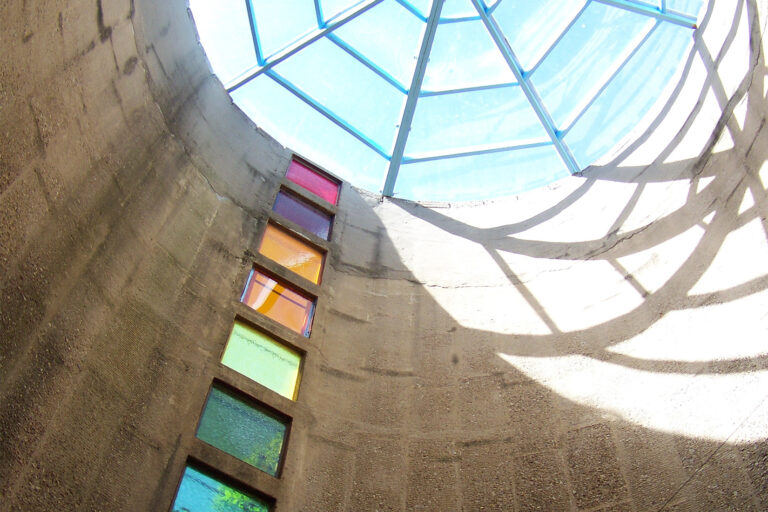
“Usually if you probe a little,” Sister Jane adds, “I think many of the RVers at Harvest Hosts are looking for different experiences, and they’re willing to go off the interstate to find them.”
Both Teresa and Sister Jane understand the draw of the farm as a novelty. (It is after all an alpaca farm run by sisters.) But what the experience offers does seem to be tailor-made for RVers. For example, Harvest Hosts members are supposed to buy something on location. At Heartland Farm, there are alpaca goods and yarn, jellies and jams, soaps and creams, all made by the sisters.
Sister Jane gets it. “I noticed about RVs that most don’t have much room to just collect stuff. And so they appreciate things like a jar of jelly that they’re going to use tomorrow or the eggs from the chickens.” Others want clothing made from the local alpacas, because it’s a personal connection with the farm and will help keep them warm on the road.
Indeed, for every guest who visits Heartland Farm, that unique connection is something unforgettable, far beyond yarn and jam. It’s tightly knit to the soul.
“Usually if you probe a little, I think many of the RVers at Harvest Hosts are looking for different experiences, and they’re willing to go off the interstate to find them.”
Just Follow the Path
Last year, CEO Joel Holland mentioned Heartland Farm as part of his Harvest Hosts origin story. Before he helped turn the membership into a 21st century operation, he visited as many sites as he could. Deep down, he knew people were looking for unique experiences. Then he arrived at this alpaca farm run by sisters—one of whom gave guests massages. (Sadly for guests and her fellow sisters, she has since retired from the massage table.) But that was a unique experience. And a path opened for Harvest Hosts.
Although the farm is out in the flatlands of Kansas, there are several paths that connect here. Just a half hour to the southwest lies Fort Larned, a hub around which Indian wars raged in the late 1800s. Within an hour to the east lie two significant wetlands, Cheyenne Bottoms Wildlife Area and Quivira National Wildlife Refuge, a stopping place for migratory waterfowl. Sister Jane says, “You wouldn’t expect to find pelicans in the middle of Kansas, but you can find hundreds of them, as well as sandhill cranes and whooping cranes.” Birders flock on along the same path. The town of Great Bend, a half hour to the east, is 12,000 strong, but Teresa boasts it has a great steakhouse (Tellers 1872), a high-end brewhouse (Dry Lake Brewing), and a great Mexican scene (she recommends Delgado’s Mexican Food Restaurant, although Sister Jane prefers El Dos De Oros down in Larned).
But great as these day trips are, the farm itself always stands apart as the most memorable experience. Because it’s the place where room is made for the soul to stretch its wings. Where mind, body, and spirit can revive.
In the stain-glass silo, you can light a fire. And if someone comes that sings or plays, it sounds like a cathedral. You can walk along three miles of nature trails. See the plains and the creatures that dwell there, from bobcats and deer to opossums and armadillos. Concerning night, Sister Jane offers two words, “Killer stars.”
Then there’s the grass-grown labyrinth that is mown into the middle of the prairie, just inviting a first step. Sister Jane explains, “It’s a continuous pattern. It’s kind of modeled after the very famous one at Chartres Cathedral in France. Labyrinths are just a meditation trail. Unlike a maze—which is supposed to confuse you and lead you to dead ends and so on—a labyrinth is a continuous trail, so you really do get to the destination. Lots of turns, and it’s not a direct path. But you get there.” It takes 15 minutes to walk in and 15 minutes to walk out. “And,” Sister Jane adds, “however long you’d like to stay in the middle. You’re just surrounded by fields and open sky. It’s a kinetic exercise. You’re walking. … Your body kind of doesn’t have to think about where you’re going, so it opens up awareness to what’s going on inside yourself. Just follow the path.”
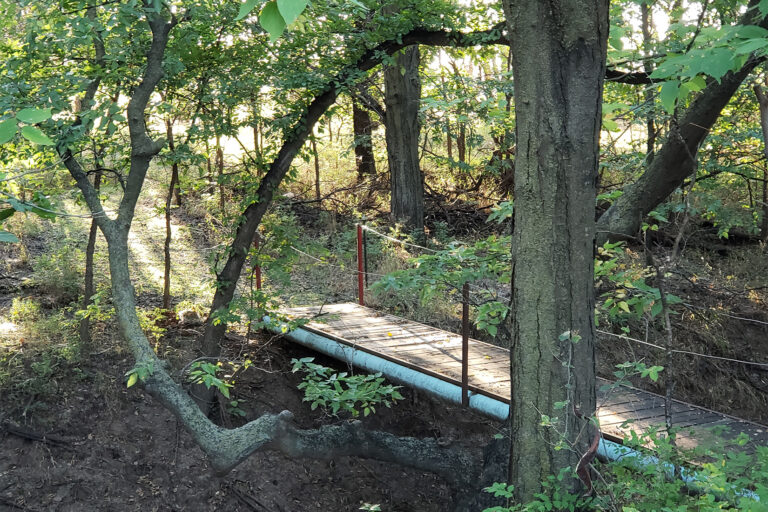
The Earth and the People in It
“I became a sister in 1963,” recounts Sister Jane. “It’s a call that doesn’t just come once but gets renewed throughout life.” Over the years, she has worked in schools, done retreats, taught art, mastered beekeeping and alpaca farming.
Taking care of the land resonates with Sister Jane, “This kind of ministry of caring for the earth and the people in it—and the whole big picture of what’s connected—is something that I think is a worthy thing to use our energies and resources for.” Teresa quickly darts in, “I like to say that Sister Jane is a jack of all trades and a master of all of them.” Sister Jane chuckles and quietly murmurs, “But I hate plumbing.”
She considers, “I think that whole hands-on engagement, rather than keeping the world at arm’s length or on a screen, is something that makes me happy. And I think for the people who come here and unplug, it’s something they crave.”
When asked about whether they had any funny stories, Sister Jane says wryly, “There was the guy who didn’t follow directions.” The story goes that a gentleman and his son were on a road trip together with a small RV (a conversion van). It had been raining on the not-so-improved roads when he called for directions. Sister Jane remembers, “So I said turn left out of the driveway. Well … he turned right. And so he took this first road—and Google Maps will tell you that it’s a road, but,” she cautions, “when there’s grass growing in the middle of it, you know it’s not a road. And so, he got about halfway through this mile, and there’s water running across the ‘road.’”
Sister Jane pauses then says, “So, he goes for it.”
You can imagine the result—the father and son duo were caught midstream amid the mucky river-bottom soil. Stuck right in the middle. So they called Sister Jane. And, like the Good Shepherd, she went to seek and save the lost.
“So, get in the truck. Grabbed the logging chains. Find him. Get around to the front. Put the chain on the front of the thing and tow it out to the corner. And his son—he’s maybe 13 or something—he’s barefoot, and there were all these little things swimming by.” Later, in gratitude, the wife stopped by to buy a gift, offer a donation, and thank the sister for coming to the rescue.
It’s a special place where Dominican Sisters of Peace are your RV recovery team. But that’s Heartland Farm. Any Harvest Hosts member who has paused to park here overnight in the drive-thru state could tell you that it is indeed a place of unforgettable experiences. A place of quiet beauty and weirdly wonderful encounters. A place where the earth and its creatures beg to be touched and cared for. A place where something lost is always being found.
3 More Weird and Wonderful Stays
Make the most of the Midwest this Spring at these Harvest Hosts locations.
Strataca Salt Mines, Kansas
Go 650 feet below the surface of the earth into
the heart of an underground salt mine. It takes just 90 seconds to descend, but there are over 150 miles of tunnels.
Golden Spike Tower, Nebraska
It’s like the train capital of the world. (Kind of.) From the top of the tower, you can watch 17 receiving and 16 departure tracks handling 14,000 rail cars every 24 hours.
Pioneer Auto Show, South Dakota
Let’s be clear: You don’t have to be an autophile
to love this place. (Although it certainly won’t hurt!) Over 275 classic cars and 60 antique tractors will captivate any guest.

